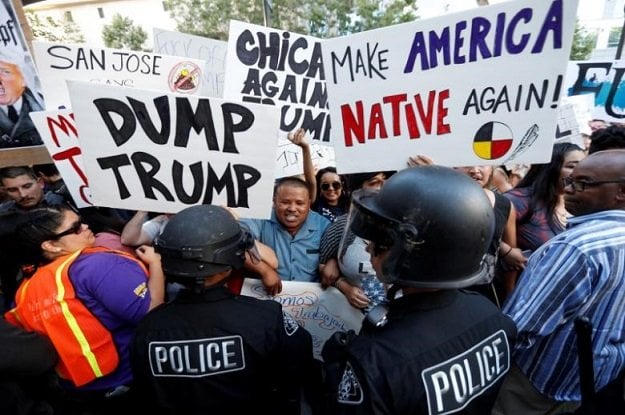
Since the US president's inauguration, daily life in multiple metropolitan centers has been carried out with the knowledge that at any moment -- and on weekends in particular -- demonstrations are unfurling in the streets below.
The final impact of the protests is yet to be determined, but with Donald Trump's term set to last at least four years and a seemingly unbridled passion welling forth in people not previously civically engaged, the rallies aren't expected to stop soon.
Trump to develop missile defense system against Iran, North Korea
"This is the first time I have ever been on the ground helping out people," Mark Hanna, a 29-year-old New York lawyer, who demonstrated and offered his services to travellers impacted by Trump's immigration decree at New York's John F Kennedy airport, told AFP.
The United States has not seen such a vast mobilisation -- women, doctors, Muslims, students, artists, gays -- since 2003, when large rallies were held against the Iraq war, said Fabio Rojas, a sociology professor at Indiana University.
A wide range of issues unites Trump's opponents, in addition to his inflammatory statements and controversial decrees.
"There is a good chance we are going to see more of it," Rojas told AFP.
The urban, anti-Trump rallies are fed by the fact that major US cities tend to skew Democrat, the party of Hillary Clinton, who lost the November presidential election in a surprise defeat.
Many liberals are still reeling after Clinton won the US popular vote but lost the state-weighted electoral college, a rare occurrence in US politics, although it happened as recently as 2000, when president George W. Bush bested Al Gore.
Social media has fired up the anti-Trump base by allowing groups to coalesce around different causes, whether women's rights, immigration or gay rights.
Experts, however, warn that if the movement is not accompanied by concrete action, it could garner little measurable effect, as was the case with Occupy Wall Street.
"In the '60s, why did they get some changes? Because they followed it up with a hammer," Rojas said of the Civil Rights movement.
The same is also true for the ultra-conservative Tea Party movement, which succeeded in pushing its own Republican party further right by propping up candidates who would compete with more mainstream GOP politicians.
"It's very hard to predict where it will go," said Dana R. Fisher, a sociologist at the University of Maryland.
"Citizens in the US are responding in ways we don't predict."
Case in point: Protests spread like wildfire following Trump's immigration and travel decree last month that saw lawyers flock en masse to airports to help those affected by the ban.
And an influx of donations was made to the American Civil Liberties Union as it fights the directive. The civil rights group raised $24 million the weekend after Trump signed his order -- six times the group's yearly average.
A call has also been placed on social networks for a general US strike on February 17. If heeded, it would "expand the repertoire" of protests in a country where strikes are rare and generally ineffective, Fisher said.
The overall protest movement could be halted, Fisher added, if Trump "could act in a way that's more presidential." But with Trump unlikely to change his behavior anytime soon, many protesters are determined to continue.
Trump to develop missile defense system against Iran, North Korea
"Protests are a part of the puzzle, but they are not going to do everything," said Lauren Irwin, 26, who has demonstrated 12 times since the inauguration.
Stephanie Murphy, a 33-year-old sweater designer, will keep marching too.
"When (Trump) sees these crowds on TV, it drives him crazy, or if I may say, it drives him crazier," she said, laughing.
1737065949-0/logan--(2)1737065949-0-405x300.webp)

1737061667-0/logan--(1)1737061667-0-165x106.webp)



1737028779-0/sidra--(100)1737028779-0-270x192.webp)
1737027357-0/sidra--(99)1737027357-0-270x192.webp)
1737026125-0/Tribune-N-(6)1737026125-0-270x192.webp)
1737025781-0/sidra--(98)1737025781-0-270x192.webp)













COMMENTS
Comments are moderated and generally will be posted if they are on-topic and not abusive.
For more information, please see our Comments FAQ